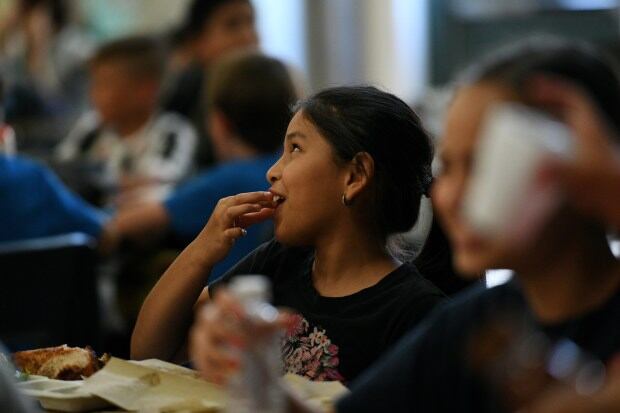Despite supply chain backups and staffing shortages, many Colorado schools have been serving more meals than ever, thanks to pandemic-related federal waivers that made school lunches free to all students.
“It’s taken a lot of stress off our families in terms of covering their living costs,” said Ashley Wheeland, policy director for Hunger Free Colorado. “We saw we could take that need off them and let them focus on their other bills.”
Now advocates are asking lawmakers to put a free school meals proposal on the November ballot to continue that benefit.
Those federal waivers are set to expire this summer, ending free lunches for thousands of students. A proposal to fill the gap with a combination of state and federal funds stalled in the state Senate, in part due to the high cost.
A bill to refer a measure to voters has the same Democratic sponsors as the stalled Senate bill: state Reps. Serena Gonzales-Gutierrez of Denver and Dafna Michaelson Jenet of Commerce City and state Sens. Rhonda Fields of Aurora and Brittany Pettersen of Lakewood.
By using what’s known as community eligibility, using eligibility for programs like Medicaid and food stamps to count children in poverty, rather than relying on families filling out applications for subsidized lunches, Colorado school districts could get the federal government to cover more meals for more students.
And by eliminating certain tax deductions for high-income filers — individuals earning more than $300,000 and couples earning more than $600,000 — the proposal would bring in an estimated $100 million a year in new state money to cover the rest of the cost, according to a fiscal analysis.
The combined revenue sources would allow participating school districts to serve meals to all students at no cost to their families. The proposal also would provide funds to buy healthy local foods, raise wages for food service workers, upgrade equipment, and train workers to prepare healthy meals, supporters said.
“Food is an important tool to learn,” Wheeland said. “No kid should be hungry while they try to get through the day. For some kids, this might be the only nutritious meal they have all day.”
The bill to place the Healthy School Meals for All initiative on the November ballot is headed to the House floor after advancing through several committees on partyline votes. There’s less than a week to get the bill through the legislature, but if lawmakers refer the measure to voters, advocates will get a big head start compared with gathering signatures, the other option.
Jasmin Ramirez, a school board member in the Roaring Fork district, told lawmakers many immigrant families in her community struggle to feed their children, despite working multiple jobs in nearby resort communities, but feel scared to fill out forms with personal information.
The district’s official records show 37% of its 5,100 students qualifying for subsidized lunches, but Ramirez said that’s an undercount, noting that many families lost jobs and burned through savings when tourism dried up.
During the last two school years, when meals have been covered, many Colorado districts report serving meals to 20% to 40% more students than before the pandemic, speaking to a greater need than was reflected in applications for free- and reduced-price lunches.
Parents and students told stories of being ashamed to be known as a “free lunch kid.” Maria Judith Alvarez said her son still avoids the cafeteria years after being sent home with a stamp on his hand for unpaid lunch debt.
Daniel Cieraszynski, a University of Denver student, recalled relying on subsidized meals in sixth grade after his father was laid off and the family had to get by on his mother’s wages as a classroom aide.
“I didn’t want anyone to know, and I felt ashamed when people found out,” he said.
Backers said covering the costs of meals for all students would remove that stigma.
But Republicans on the committee questioned why the public should carry that cost, with several saying, “There is no such thing as a free lunch.”
“I want to go back to what used to be when I was a kid,” said state Rep. Richard Holtorf, an Akron Republican. “People brought a sack lunch or a lunch box. Mom would pack a meal. Can you explain to me what happened with that?”
Dan Sharp, food services director for the Mesa Valley 51 district in western Colorado, noted that families have always struggled. Congress enacted the first school lunch program in 1946 after the Army found many draftees unfit to serve due to childhood malnutrition.
Bureau Chief Erica Meltzer covers education policy and politics and oversees Chalkbeat Colorado’s education coverage. Contact Erica at emeltzer@chalkbeat.org.







